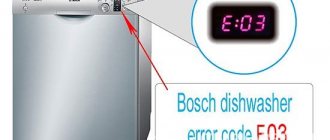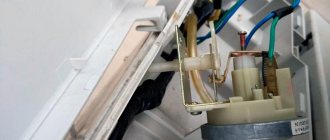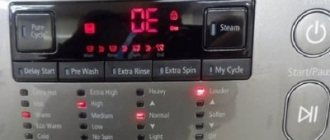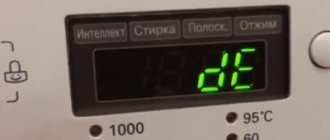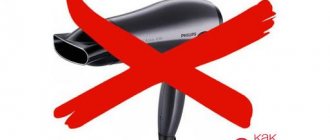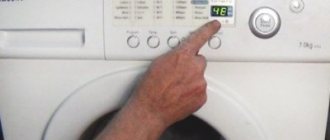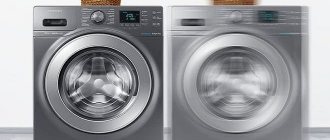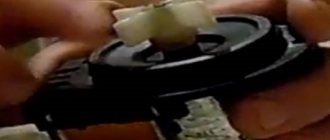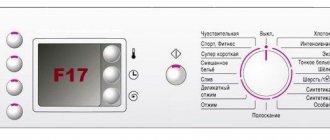An automatic washing machine (hereinafter referred to as AMA) is a complex piece of household appliance that periodically needs repair. This can happen at the most inopportune moment; in simple terms, a malfunction takes owners by surprise. For example, some owners of washing equipment are faced with a situation where the washing machine takes in water but does not wash. However, there is no need to panic. You just need to determine the cause of the breakdown and take certain measures accordingly.
Possible causes of malfunction
There are several “symptoms” that the machine is not washing. The main situations can be described as follows:
- there is water filling, but there is no subsequent rotation of the drum;
- water enters the tank, then the water drains and the motor stops, sometimes the display shows an error;
- The washer fills with water and then turns off.
Therefore, you need to carefully study what the reasons for this “behavior” of the machine are, and how to eliminate them so that the device continues to function.
Electric motor
Often it is enough to simply replace the motor brushes, although in some situations it is necessary to replace the entire part. In both cases, the part will have to be removed and then freed from the belt and sensors. You can remove the terminal on the brush using a screwdriver. You can remove the brush by using a plate. Similar actions are carried out with respect to the other brush. Next, the new brush is sent to the holder, pressed with a spring and secured.
Often the cause of a malfunction may be the lack of sufficient current for natural starting. In this case, you will need to replace the capacitor or rewind it. Sometimes the motor unit does not start due to overheating; in this case, water is collected, but washing is not. The reason is the launch of several washes in a row. Sometimes it’s enough to give the washer time to cool down.
If water is pouring in, but the drum does not rotate, there is no noise, then the problem is the combustion of the commutator motor. Along with this, the starting capacitor may also fail. On models equipped with a display, the corresponding lamp may light up. In any of these situations, a comprehensive engine repair or replacement will be required. The same goes for pumps that have stopped rotating.
Drum jammed
If the washer fills with water but the drum refuses to spin, the reason is usually that the program ended without spinning the laundry. Self-diagnosis traditionally consists of the following steps:
- checking the load (the size of the washing machine load, which can be small or large, in any case, uniform distribution of clothes throughout the compartment is required to maintain balance; if it is absent, the control module will fail);
- checking the belt (probably it has simply come off the engine, just open the door and turn the element by hand, free rotation and lack of resistance indicate it has fallen off);
- checking the washing cycle (you need to select the standard cycle and activate the device, it should fill with water, as a result the drum will turn over, if it is idle, you can talk about the breakdown of the brushes or the control module).
If none of the above steps helps, you should contact a service center.
The heating element is faulty
If there is no water heating, this is due to a breakdown of the heating element. The fact is that for normal operation it is enough to use cold water, because the heating element subsequently provides it with a normal temperature. If the heating element fails, you will not be able to solve the problem yourself, especially if an error message appears on the display.
The heating element itself is located under the drum. First you need to disconnect the elements from the terminals, and then use a multimeter to carry out diagnostics. Probes are placed at the element terminals. If it is working, the value will be in the range of 20-25 Ohms.
An important role is played by checking the temperature sensor located near the heating element. It is pulled out and disconnected from the plug. The multimeter is then used again with the resistance set to a higher level. The sensor will display readings from 20 to 50 ohms. If the sensor is working properly, the readings will decrease when you touch it. After this, you need to make sure that there are no situations such as combustion or blocking.
Damage to the water level sensor
In this case, the washing machine draws water, and then immediately drains it and refuses to wash. If the washing machine model is equipped with a display, it may display a pressure switch error. In all these situations, we are talking about problems with the pressure switch tube, which can fly off or become clogged. It is often subject to various damages. Sometimes the pressure sampling chamber becomes dirty, or the sensor fails. The bottom line is that the SMA is not able to determine the volume of water inside, so it drains and the engine stops. To solve the problem you need to blow out the tube.
Control module
A defect on the circuit board may interfere with the motor as the drum rotates. Since the main problem lies in the electrical part, in this case it is impossible to do without the services of a competent technician. Only an experienced expert will carry out diagnostics and testing of this element using a stand. After all, it is impossible to understand what happened by sight, especially if there are no traces on the parts and paths. Even if they are available, soldering of the board will be required, and this process is long and painstaking, and a person without experience and skills simply cannot cope with it.
Bearing wear
The rotation of the drum during use of the washing machine is carried out using a bearing, which reduces friction. This indicates the importance of these elements. However, due to their regular getting wet, breakdown can occur quickly. If the washer makes too much noise, they are to blame!
Practice shows that all this happens after about 10 years of operation of the unit. It is also worth noting that excessive noise may be a sign of a broken pump or motor, as well as shock absorbers and belt. The problem occurs during the spin cycle.
Wiring fault
If, after drawing water, the drum suddenly stops, and the display appears blinking or completely fades, the reason may lie in a breakdown of the electrical wiring. You can find wires that have burned out through a visual inspection, accompanied by ringing the basic elements of the circuit. The same approach will prevent short circuits.
Drive belt is faulty
If the device is equipped with a direct drive, this malfunction cannot occur, because The belt is simply missing. If the drive is different, you should start self-diagnosis from this point, because it is the most common reason for the machine taking on water and not washing.
So what can actually happen to a belt? There are quite a lot of reasons. It often falls off during transportation or wears out due to prolonged maintenance and needs to be replaced. In all SMAs where belt transmission and front loading are provided, the belt is located at the rear of the body. If it is vertical, the element is located behind the lid on the side. When removing it, there are usually no problems; unscrewing all the bolts is enough.
If the belt falls off, it is simply pulled out of the housing and then carefully inspected for breakages and defects. If they are present, the element is replaced. To put on a new belt, you need to place it on the engine, pull it up and over the pulley, and then slide it all the way on.
As for other reasons for the lack of washing when drawing water, they can be described as follows:
- the centrifuge is jammed if, for example, foreign objects appear between it and the tank in the form of a bolt, clamps, hose, accessories from things, etc.;
- the main board is broken (the fault can be determined by visual inspection, detecting blackening of the contacts or their groups);
- the pressure switch is out of order, it can overfill or underfill water, you just need to carry out diagnostics and repairs with replacement;
- the impeller is clogged due to foreign objects getting inside;
- the wiring has become unusable, in this case, after filling with water, the drum simply stands up and refuses to work;
- work in semi-automatic mode;
- penetration of air into the pump, failure to start certain modes.
These are not all the causes of breakdowns, but they are the main ones and deserve special attention.
The drive belt has fallen off
Symptoms: the machine has filled with water, but the wash does not start.
A loose belt is one of the most common causes of failure in a washing program. The belt may become dislodged due to improper installation or rough handling. It can also wear out over long periods of use and become weakened. In principle, you can put the belt on the engine yourself, but keep in mind that this will require disassembling the washing machine, and replacing a worn belt will make it difficult to find a suitable replacement.
Do-it-yourself troubleshooting
You can solve some problems on your own.
Replacing the heating element
When water is collected, the heating element is activated for heating. When the liquid reaches a certain temperature, the sensor responsible for starting the motor starts working. In the absence of heating, rotation does not begin. To get to this unit, you need to open the ACM panel at the back, in the lower area of the tank and the heating element will be located.
In order to remove the heating element, you need to unscrew the central nut, and then deepen the bolt by tapping it a little. You will need a flat head screwdriver to get it out. At the first stage, the scale layer is removed. If there are black spots, it is a breakdown and needs to be replaced. If they are not there, you need to turn on the tester for diagnostics.
There is a rubber gasket on the body of the element; there is a bolt in the center of it. When the nut is screwed on, the seal expands and falls into the tank. You need to insert it as carefully as possible. If you neglect this point, the drum will cling and the operation of the device will become incorrect.
Removing drum blockage
As noted, one of the first steps to take is to check the drum for mechanical blockages. Rotation may be impaired due to foreign objects getting between the tank and the drum. Only after removing them will the device be restored.
Troubleshooting drive belt problems
If the drive is direct, there is no belt in the device. For such machines, the action item in question is not relevant. As for the remaining units, it will be necessary to find the reasons for the lack of rotation of the drum, and this process should begin by checking the belt. If the device is equipped with a vertical loading system, the belt is located behind the side. In turn, in front-loading SMA it is present at the back.
The wall should be removed as easily as possible, without much difficulty. This can be done by unscrewing the mounting screws that hold the panel in place. A belt that has come off must be inspected as carefully as possible. If there are tears and abrasions on it, it is likely that it has come off. In this case, you cannot do without a replacement. To install the belt, you need to pull it onto the motor pulley, and then direct one part to the drum pulley.
Replacing motor brushes
A malfunction of the electric motor can also lead to a lack of washing. The most common problems in this case are situations such as wear of the brushes, lack of functioning of the starting capacitor, and overheating of the element in the event of a long wash the day before. To change the brushes yourself, you must follow the following algorithm:
- Remove the motor and unscrew a few bolts.
- Remove the belt and sensors.
- Remove the terminal from the brush using a screwdriver.
- Remove the carbon electrode by first unscrewing the bolts or releasing the spring. If the length of this element is less than one and a half centimeters, replacement is impossible. It is also important to take into account the coal and its ground end.
- After this, the brush is taken out. The master must remember exactly where the coal was ground off. You can even take a photo for this.
It is important that the new brushes are suitable for the specific model of the unit. You can find out information about it from the markings presented on the case. Replacement of coals is carried out exclusively in pairs. That is, it is impossible to make sure that one brush is replaced, and the second remains worn out.
The next step involves cleaning the collector from dust particles and mechanical damage. To do this, you need to prepare sandpaper (it should be as fine as possible), and then apply it to the commutator and rotate the shaft.
Rotation should continue until the commutator surface is cleaned and polished. Next, the carbon elements are installed at the correct angle, as well as secured with screws. To complete the repair work, you will need to place the motor in the housing compartment and connect the sensors with the belt, and also close the cover.
In what cases should you contact a specialist?
If all of the above items have been checked and there are no faults, the problem is likely affecting the control module. However, this fact does not always act as a reason for the lack of washing after starting the program and drawing water.
If the problem concerns an electronic board, only a professional can handle the task in question. Only he will determine the possibility of repair and its feasibility, and will also tell which parts urgently need replacement. Even if you have an understanding of the basics of electronics, it is not recommended to repair the device yourself, because... such “repairs” can lead to even more problems.
If a breakdown occurs suddenly and takes you by surprise, in most situations you can deal with it on your own, i.e. no need to call a technician. This will save money and nerves, because... Not every specialist does his job well. If the problem has been making itself known for a long time, and the machine finally breaks down, you need to contact a service center or call a specialist to your home.
Precautionary measures
To prevent the causes of breakdowns of this nature, you need to follow several recommendations from experts:
- It is necessary to install a tap that regulates the amount of incoming liquid. Its presence allows you to extend the life of the intake valve.
- Additionally, a siphon valve is installed - a device that prevents sewage water from entering the appliance drum during washing.
- Before draining the washing machine, you need to make sure that the settings on the control panel have been selected correctly.
- To prevent the machine from drawing water on its own when it is turned off, you need to secure a leakage protection system to the floor - this will extend the service life of the equipment.
In conclusion, I would like to add that despite the independent actions of your main assistants when washing things, you should not leave them unattended while working.
Modern units are also equipped with timers to delay the turn-on time of devices, but you should not trust them again, and not because of their unreliability; a short-term power surge, for example, during a lightning strike, can also cause a breakdown.

